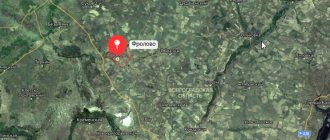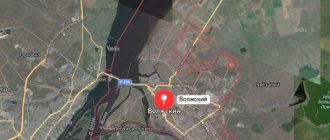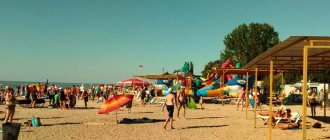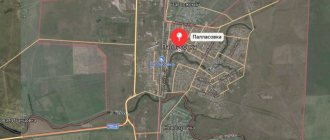There are cities in Russia that are familiar to everyone from school. Without these cities and towns, the fate of Russia could have developed according to a completely different scenario. Each of them is important and has deep historical significance. In the south of Russia, in the Rostov region in particular, such a great patriarch is the ancient city of Azov.
This land, where the Don flows into the Sea of Azov, has been a tasty morsel for many peoples and great powers for more than 2,000 years. The owner of Azov controlled access to the southern seas and was the master in the Azov region. The city remembers the era of commercial flourishing, Persian caravans, bloody battles and the valor of Russian soldiers beyond scientific explanation. And even though it has now lost its military significance, having turned into a deep Russian province, everyone who comes to the Don land should visit Azov. Read about what this city is famous for and how to get to Azov in this post.
A little history
You can’t tell about Azov in a few words. His story is so complex and dramatic that it could serve as the basis for a multi-hour lecture. You can read more fully about the history of Azov in the following posts. Today I will try to tell you the most interesting things.
The first settlements on the site of Azov appeared in the 1st century. BC. They were founded by Meotian farmers who actively traded with the Greek city of Tanais.
In the 3rd century. nomads destroyed settlements, taking possession of beautiful pastures under the warm southern sun. Sarmatians and Huns, Scythians and Khazars, Pechenegs and Polovtsians settled here.
In Russian chronicles, the settlement was first mentioned in 1067. In this year, the city of Azak was founded on the site of the death of the Polovtsian Khan Azup (probably the name of the settlement is associated with the name of the khan).
In the 12th century. The Venetian trading post of Tana was located near the banks of the Don. This place was extremely important in trade between East and West. It was a transit point on the Great Silk Road. Having learned about this, the Tatars also wanted to own land on the Don. In a matter of years, a populous trading city of the Golden Horde grew up next to the Italian colony. It retained its former name – Azak.
Trading cities of Azak and Tana
Azak and Tana were so close to each other that many considered them to be one settlement. In order to somehow protect themselves from the Tatars, the Italians begged Uzbek Khan to allow them to surround the Tana quarters with a wall, for which they agreed to pay tribute and trade duties.
In 1395, the thriving trade center was completely destroyed by Tamerlane's troops. He never achieved more than his former greatness.
In the 15th century, Turks appeared in the place of Azak and Tana. They completely destroyed the cities, establishing their fortress here - Azov.
Turkish fortress Azov. Reconstruction
From a large trading city, Azov turned into a defensive Turkish fortification in southern Russia. The Cossacks who settled on the Don were greatly annoyed by the nearby Turkish fortress.
In 1637, at a meeting of the Military Circle in the Monastic Town, a decision was made to attack Azov. After 2 months, the enemy was driven out of the territory. The Turkish fortress passed to the Don Army.
Cossacks march to Azov
In 1638, the Crimean Khan tried to take possession of the fortified outpost, but his small army was defeated. The Turks decided to regain the fortress at any cost. In 1641, having gathered an army of 250 thousand, they approached Azov, where at that time there were only 5,000 Cossacks. “The ground trembled from the number of enemies, and the Don overflowed its banks,” eyewitnesses recalled. For 93 days and nights the Cherkasy Cossacks valiantly defended the Russian bastion. This was a great battle, which went down in history as the “Azov Siege.”
Azov siege seat
The completely exhausted Cossacks finally knocked out the enemy, and the Ottomans were forced to flee. But after 2 years, having received no support from the capital, the Cossacks left dilapidated Azov and returned home to the town of Monastyrsky. The Turks took advantage of this and again occupied the Azov fortress, destroying the Cossack monastery town.
A new battle for the southern seas began with the coming to power of Peter I. In the 17th century. Azov found itself at the center of historical events of the Russian Empire. The Azov campaigns, the formation of the Azov fleet, the Russian-Turkish wars... He finally joined Russia in 1774.
Azov campaigns of Peter I
By the beginning of the 19th century. Russia's borders moved to Kuban, and the city of Azov lost its military significance. Gradually it became an ordinary provincial town. But in the middle of the 19th century. The Crimean War recalled the possibility of organizing a military fortress in Azov. Military warehouses, artillery batteries were located here, and fortification work was carried out. The ships of the Russian flotilla kept a constant watch in the port. The war ended and dull provincial life began again in Azov. He appeared in newspaper reports only in 1901, when, close to him, the Russian physicist A. Popov designed the first civilian radio station in Russia.
And then there was a civil war and German occupation... The fate of many Russian cities in the twentieth century. look like a carbon copy. The establishment of Soviet power, the rapid growth of industry, the Great Patriotic War... The German occupation lasted seven months. Every second house was destroyed.
In the post-war years, industry developed rapidly in the city, enterprises and housing were built. In 1953, after the construction of the Volga-Don Canal, the port of Azov became a port of five seas, which to this day retains its international significance.
Temple of the Icon of the Mother of God of Azov
All Orthodox residents and tourists of the city are gathered under its arches by the temple of the icon of the Mother of God of Azov. The blessing for the creation of the temple was received in 1993, and in 1996 design and construction work began on its construction, which dragged on for 10 long years. In 2007, a bell called “Prince Vladimir” was erected on the bell tower of the temple, which was presented to the temple by the governor of the Sverdlovsk region V.F. Chuba. Until 2009, they continued to decorate the temple. Today, the Church of the Icon of the Mother of God of Azov can accommodate up to 300 parishioners at a time.
Location: Makarovsky street - 25.
Azov today
Modern Azov is a quiet, very green and cozy city with a population of just over 80 thousand people. The industrial zone is located outside the residential areas, and the center has become a great place for walking and studying history.
Modern city of Azov
Along the banks of the Don, the ramparts of the Azov fortress, a ditch, and the Alekseevsky Gate have been preserved. The Powder Magazine, a monument to the military engineering art of the 18th century, as well as a small fragment of the wall of the Italian trading post of Tana, and a large port have been preserved here. But, perhaps, the brightest pearl in this necklace remains the Azov Museum of Local Lore, which allows you to look at Azov with completely different eyes, imbued with the spirit of respectful respect for the glorious history of this incredible southern city.
Geography and natural resources
The Azov region is located in the southwest of the region and occupies the southern coast of the Taganrog Bay and the Don River delta. The area is rich in natural landscapes. The southern Russian steppe, coastal areas, and protected areas of the Don delta coexist here. In 1884, the Aleksandrovsky forest (formerly the Ataman forestry) was planted. To the north of the Obukhovka farm there is a large promising oil and gas field. The right bank of the Taganrog Bay is rich in dense shell rock, which serves as a good material for filling roads in villages and hamlets of the Don Delta. Large sand reserves are available in the area of the villages: Kagalnika, Kuleshovka, Samara, Pavlovka, Novomargaritovo and Port Katona. The oldest of them, Azov, was explored back in 1949-1953. and has an estimated reserve of about 10 thousand tons. There are also: gas deposits (Peshkovskoye), clay deposits (Kagalnitskoye), hydrogen sulfide mud (Lake Pelenkino), marl deposits at a depth of 300-500 m.
District structure
Within the district:
- Alexandrovskoe rural settlement;
- Elizavetinskoe rural settlement;
- Elizavetovo rural settlement;
- Zadonsk rural settlement;
- Kagalnitskoye rural settlement;
- Kalinovskoe rural settlement;
- Krasnosadovskoe rural settlement;
- Kruglyanskoe rural settlement;
- Kugey rural settlement;
- Kuleshovskoe rural settlement;
- Margaritovskoye rural settlement;
- Novoaleksandrovskoe rural settlement;
- Obilnenskoye rural settlement;
- Otradovskoe rural settlement;
- Peshkovskoye rural settlement;
- Rogozhkinskoe rural settlement;
- Samara rural settlement;
- Semibalkovskoye rural settlement.
How to get to Azov?
The close proximity of Azov to Rostov-on-Don (only 37 km) makes it an easily accessible destination for any traveler who comes to the Don land. By car this journey will take no more than 40-50 minutes. GPS coordinates: 47.1, 39.416667 (47° 6′ 0″ N, 39° 25′ 0″ E).
If you don’t have a car, you can get to Azov by bus, minibus or commuter train. Minibuses and minibuses depart from Rostov-on-Don: from the Main Bus Station (ticket office at platform No. 1) every half hour; from Station Square at intervals of 10-15 minutes. You will have to spend a little over an hour on the way.
The commuter train to Azov does not depart as often as buses and minibuses. More complete information about the movement of electric trains can be obtained at the ticket office of the Prigorodny railway station or Yandex.Schedule.
Agriculture
Crop production
In terms of its production profile, the Azov region is agricultural and in recent years has been steadily developing as a single agro-industrial complex. A scientifically based farming system is being introduced on farms, correct agricultural cultivation techniques are used, and variety renewal is carried out in a timely manner using high-yielding varieties of agricultural crops. Gross grain production has increased, and the yield of all agricultural crops has increased significantly. For grains, the growth over five years was 12.6 c/ha, for sunflower – 6.2 c/ha, for vegetables – 61.8 c/ha. The district leadership is pursuing a policy of reorganizing all unprofitable and low-profitable enterprises; there are practically no unprofitable farms left in the district. In general, the profitability of the agricultural industry is 35-40%. The best results in crop production were achieved by the following farms: named after Dzerzhinsky, “Rybak Priazovya”, “Zarya”, “Pobeda”, “Primorsky”, where the grain yield “per round” exceeded 44 c/ha. In the fishing industry, the diversified enterprise “Socialist Way” sets the tone.
Livestock
In terms of a set of quality indicators in livestock farming, the Azov region is a leader among other regions of the region. This result became possible thanks to the introduction of advanced technologies in farms and the adoption of non-standard solutions by the district leadership in this industry. For example, the task of increasing the number of livestock at the expense of farms that have not previously been involved in livestock farming is being successfully solved. The breed achieved the highest milk yield per cow in the region – approx. 5 thousand liters per year. The feed mill and other agricultural enterprises of the Azov region have close ties of cooperation with a number of Dutch and German companies in terms of cultivation, joint production and processing of agricultural products.
Sports, tourism
Physical education and sports are actively developing in the Azov region. The total number of people regularly involved in physical education and sports exceeds 10 thousand people. Football, volleyball, chess, athletics, sailing, equestrian and weightlifting, Greco-Roman wrestling, cycling, and billiards are very popular among residents. Field hockey is actively cultivated. In recent years, athletes from the Azov region have achieved great success at international, all-Russian, regional competitions, and were winners of the regional rural sports competition. The material sports base is being updated in the region: the construction of a specialized sports complex for team sports has begun in the village of Kuleshovka, it is planned to build a large sports complex in the village of Port Katon, and the construction of a modern rural stadium in the village of Otradovka. The head of the district, V.N. Bevzyuk, is actively involved in sports and is the president of the district teenage club “Centaur”.
The nature and climate of the Azov region contribute to the development of tourism. In the summer months in the Azov region you can meet vacationers from all regions of Russia. Magnificent tourist complexes are at your service: “Cossack Watch”, “Breeze”, “Alexandrovsky Forest”.
Education
The structure of the education system in the Azov region is the largest in the region. It unites 70 educational schools, 2 children's creativity centers, 40 kindergartens and other educational institutions. The material base of educational institutions in the region is being strengthened. Recently, 6 schools and 3 kindergartens have been overhauled. Preschool educational institutions have been reopened in the villages: Novomargaritovo, Otradovka, Orlovka, Novoaleksandrovka, Ovoshchnoy. Modern computer classes have been opened in 29 secondary and 14 basic schools. Every month, the most gifted children are paid a personal scholarship from the head of the Azov region. The region has accumulated a wealth of experience in military-patriotic education of youth. Every year, the military sports game “Zarnitsa” is held in the Alexander Forest.
Population and labor resources
The Azov region is the largest in terms of population in the region. According to the 2002 population census, the number of residents of the district is 92 thousand 568 people. There are 99 settlements on the territory of the Azov region. The largest of them by number of inhabitants (2002 census data): Kuleshovka (14,690), Samara (10,654), Kagalnik (7,951), Aleksandrovka (4,738), Peshkovo (3,601), Krugloye (2,299), Ovoshchnoy (2,210 ), Red Garden (2127), Port Katon (1778), Elizavetovka (1882), Semibalki (1778), Kugey (1619). Representatives of more than 20 nationalities live in the area. Migration remains the main source of population growth.
Health and culture
The district's network of healthcare institutions includes 2 district hospitals, 5 district hospitals, 9 outpatient clinics, 50 first-aid posts. Three honored doctors of the Russian Federation and 20 excellent health care doctors work in the district’s medical institutions. The intensive care unit of the Central District Hospital has been opened, and significant additional funds are allocated annually for major repairs of healthcare facilities. A major overhaul of the Azov Central Regional Hospital is underway, as well as the construction of a maternity hospital with 80 beds. Medical equipment is constantly being updated.
In the district there are 51 Houses of Culture, 44 libraries, 9 music schools and 8 branches, one cinema, 17 film installations. There are more than 300 club formations (circles, associations, clubs) in the district’s cultural institutions, with about 5 thousand participants. Creative groups of the district are regular participants in regional competitions. The children's theater-studio "Gorodok" of the Kuleshov Regional Social Rehabilitation Center became a diploma winner at the All-Russian Children's Theater Festival in Kaluga.









